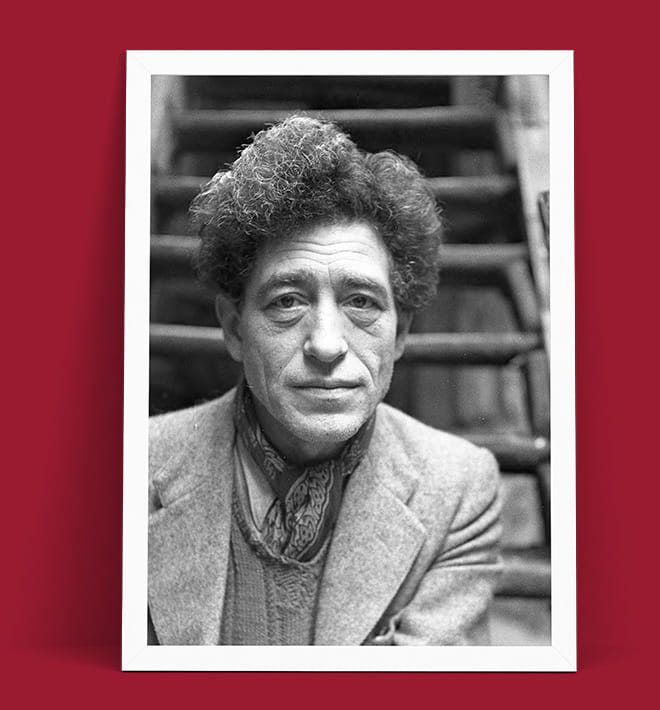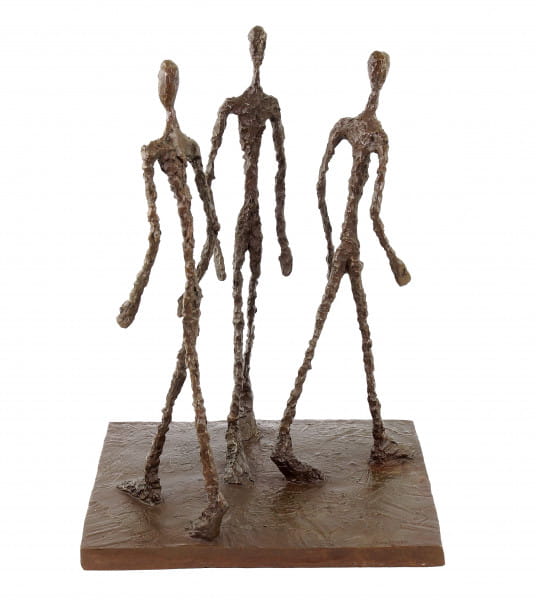Prices incl. VAT, free shipping worldwide
Ready to ship today,
Delivery time appr. 3-6 workdays










Product description
"Three Men Walking II - Alberto Giacometti Sculptures"
| Height | 42 cm |
| Width | 26 cm |
| Length | 30 cm |
| Weight | 6 kg |
An Architecture of Isolation - Three Men Walking II - Signed Giacometti
Although Three Men Walking II consists of a group, the figures do not interact. Each walks in his own invisible corridor of space, slightly misaligned in posture and position. They are together, but alone. This structural isolation within apparent proximity is a hallmark of Giacometti Art, reflecting the artist's belief that no two beings can ever fully occupy the same mental or emotional reality. The arrangement of these men—silent, inward, and motion-bound—evokes the unbridgeable distances between individuals in modern life. Their positions are staggered, their paths parallel but non-intersecting. The work becomes a metaphor for urban existence, for the psychological conditions of the postwar era, and for the fragile dignity of forward motion despite fragmentation.
A Life Sculpted by Distance and Light
Alberto Giacometti was born on October 10, 1901, in the mountain village of Borgonovo, in the Val Bregaglia region of Switzerland. Surrounded by alpine silence and the legacy of his father, the post-impressionist painter Giovanni Giacometti, he developed an acute visual sensitivity and began sculpting at an early age. His early exposure to painting, drawing, and the philosophical solitude of the landscape laid the foundation for a unique artistic vocabulary that would later evolve into the language of Giacometti Sculptures. In 1922, Giacometti moved to Paris and became part of the city's vibrant intellectual milieu, engaging with Cubism, Surrealism, and later the existentialists. His mature work, however, broke radically from these movements and established a visual grammar of absence, isolation, and quiet endurance that remains unmatched in modern sculpture.
Postwar Paris and the Emergence of the Walking Figure
The end of World War II marked a turning point in Alberto Giacometti's creative evolution. After years of introspection and exile in Switzerland during the war, he returned to Paris in 1945 and began producing works that radically reduced the human form to its essential presence. It was during this profoundly philosophical period that the motif of the walking figure emerged—a figure no longer defined by musculature or narrative but by the act of moving through space. Three Men Walking II, created in the late 1940s or early 1950s, is one of the most poignant expressions of this concept. Rather than representing men with individual identity, the figures in this group embody the anonymous condition of modern humanity—fragmented, solitary, yet caught in the same rhythm of persistence. This sculpture belongs to the pantheon of essential Giacometti Sculptures, alongside L’Homme qui marche and La Place, that redefined how movement and presence could be rendered in bronze.
Bronze That Bears the Imprint of Thought
The materiality of this sculpture is inseparable from its emotional resonance. Cast in dark, heavily textured bronze, the figures retain the exact gestures of the artist’s hand. Giacometti did not smooth his forms; he left them raw, scraped, and eroded, as if shaped by wind or memory. These surfaces shimmer with tension, catching the light only to dissolve into shadow. The material becomes a metaphor for perception itself—unstable, wavering, filled with uncertainty. As with all great Alberto Giacometti artwork, the bronze in Three Men Walking II does not conceal process; it reveals it, turning the act of sculpting into a visual record of doubt and desire.
Movement Without Arrival
The men in this composition walk, but towards what? Their steps are frozen mid-gesture, their direction open-ended. They move, but they don't arrive. Giacometti once said that “the human figure is always in motion, even when it stands still.” In Three Men Walking II, motion becomes a state of being, not a means to an end. These are not heroic striders, but quiet witnesses to the slow progression of time. In this way, the sculpture captures one of the central insights of Giacometti Art: that the act of walking—of continuing—is perhaps the most human of all gestures, especially when it carries no promise of destination.
A Composition of Equal Weight and Solitude
Although the figures differ slightly in height and gait, they share the same existential tension. Their elongated limbs, narrow torsos, and absent features render them nearly indistinct from one another. Yet each carries his own solitude. The base they walk upon is neutral, unadorned, offering no clues as to place or context. It is this abstraction that allows the sculpture to transcend the personal and become universal. As a group, they echo Giacometti's own daily observations of pedestrians walking the streets of Montparnasse, captured not in detail but in rhythm. The anonymity of the figures is precisely what gives them emotional depth—each is no one, and therefore everyone.
The Collective That Remains Individual
The three figures share a space but not a gaze. They move in synchrony but not in unison. They are defined not by interaction, but by mutual solitude. This contradiction is what gives Three Men Walking II its uncanny emotional resonance. It is both a sculpture of community and a sculpture of isolation. It reflects a world in which we walk beside each other without touching, in which nearness does not always mean connection. Such insights are central to Giacometti Art, which captures the human condition not through narrative but through form, through space, through silence.
A Procession of Persistence
Three Men Walking II by Alberto Giacometti is not simply a sculptural group—it is a meditation cast in bronze. It is a procession of memory, of being, of continuity without resolution. In their thinness lies their strength. In their repetition, their difference. In their direction, their uncertainty. They do not call attention to themselves, and yet they are unforgettable. Among the many masterpieces of Giacometti Sculptures, this work is perhaps the most honest: a vision of men who walk because walking is what remains, a gesture that endures even when all else has fallen silent.
Our advantages
free shipping
Worldwide free shipping
14 days money back
You can cancel your order
within 14 days
secure payment services
Paypal, Master Card, Visa, American Express and more






















































